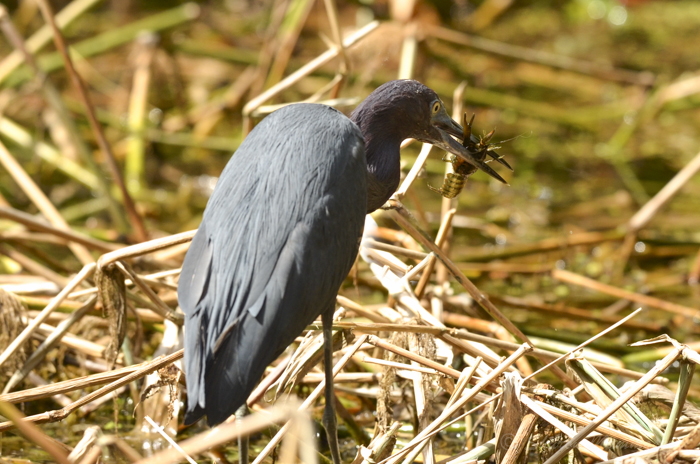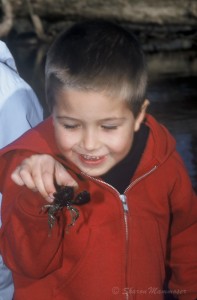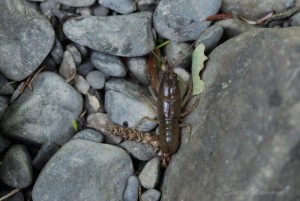 Years ago I was conducting a river study with a group of middle school students in Middleburgh, New York when we caught this crayfish. It was hard to miss the way the crayfish held its tail curled back around its body, obviously trying to cover something. When we looked more closely and moved the tail out of the way, I was thrilled to see all of these tiny dots, which I knew to be crayfish eggs but had never seen before. The fertilized eggs are attached to the abdomen and the females will carry them like this for 2-10 weeks depending on the temperature of the water. A female in this condition is said to be “in berry,” because the tiny eggs resemble berries. She can have anywhere from 10-800 eggs! Females “in berry” are often found in May or June. When the eggs finally hatch into mini crayfish, the new babies will continue to be attached to the abdomen by a thin stalk. When they shed their skins for the first time, they will lose the connection with the female but remain with her for up to 2 weeks before leading independent lives.
Years ago I was conducting a river study with a group of middle school students in Middleburgh, New York when we caught this crayfish. It was hard to miss the way the crayfish held its tail curled back around its body, obviously trying to cover something. When we looked more closely and moved the tail out of the way, I was thrilled to see all of these tiny dots, which I knew to be crayfish eggs but had never seen before. The fertilized eggs are attached to the abdomen and the females will carry them like this for 2-10 weeks depending on the temperature of the water. A female in this condition is said to be “in berry,” because the tiny eggs resemble berries. She can have anywhere from 10-800 eggs! Females “in berry” are often found in May or June. When the eggs finally hatch into mini crayfish, the new babies will continue to be attached to the abdomen by a thin stalk. When they shed their skins for the first time, they will lose the connection with the female but remain with her for up to 2 weeks before leading independent lives.
Crayfish, like their deep sea cousins, the lobster, are crustaceans. Like all invertebrates they lack a backbone, but have a hard exoskeleton. There are 500 species of crayfish in the world, with more than half of those living in the United States. There are no crayfish in Africa or Antarctica and not all crayfish live in water, though certainly most do. There is at least one kind of crayfish that dwell in caves. These are colorless and have no eyes. The world’s largest freshwater invertebrate is the crayfish that live in Australia; these can grow up to 31 inches long and live for 40 years! Most crayfish in the wild do not live this long.
Most crayfish live in freshwater, hiding during the day under rocks and other debris or burrowing down under leaves or mud. When darkness falls, they emerge to feed. Crayfish are omnivores, meaning they eat both plant and animal matter. Though they will take live prey such as a minnow or other aquatic invertebrates if the opportunity arises, many feed mostly on decaying plant and animal material.

Many animals feed on crayfish, including birds, turtles, otters and raccoons. In places such as France and the southern United States, eating crayfish is not uncommon. Louisiana produces (for eating!) around 100 million pounds of crayfish each year!
 Like other invertebrates, crayfish, also called crawdads, grow by molting, or shedding their old skin and replacing it with a new one. To reclaim the calcium and phosphates, they will eat their old skin. After 6-10 molts, they reach sexual maturity. Crayfish have four pairs of walking legs and four pairs of swimming legs. They also have two pair of antennae and a pair of claws or pinchers that they use for cutting and capturing food, attack and defense. If they lose a claw or leg, they can regenerate a new one. Crayfish have eyes on movable stalks and can move these eyes independently.
Like other invertebrates, crayfish, also called crawdads, grow by molting, or shedding their old skin and replacing it with a new one. To reclaim the calcium and phosphates, they will eat their old skin. After 6-10 molts, they reach sexual maturity. Crayfish have four pairs of walking legs and four pairs of swimming legs. They also have two pair of antennae and a pair of claws or pinchers that they use for cutting and capturing food, attack and defense. If they lose a claw or leg, they can regenerate a new one. Crayfish have eyes on movable stalks and can move these eyes independently.
Some crayfish dig burrows using their claws and tails. They will extract mud from underground and create a “chimney” at the entrance. This hides the burrow and protects them against snakes and other predators. If you are walking along a river and see a bunch of piles of mud, this could be from the burrows of crayfish.
Have you ever caught a crayfish? If so, you might know that they tend to move backwards quickly when threatened from the front. If you want to hold one, grab it right on the middle of its body, behind the pinchers. This way, they crayfish cannot grab you with its claws. Have you ever been pinched by one? I have! And it’s not as bad as it might seem. The big crayfish can pinch pretty hard but it’s not even close to being as painful like a yellow jacket sting. It just kind-of pinches a little! If you immerse the crayfish and limb that’s being pinched into water, the crayfish will usually let go and dart off to safety.

